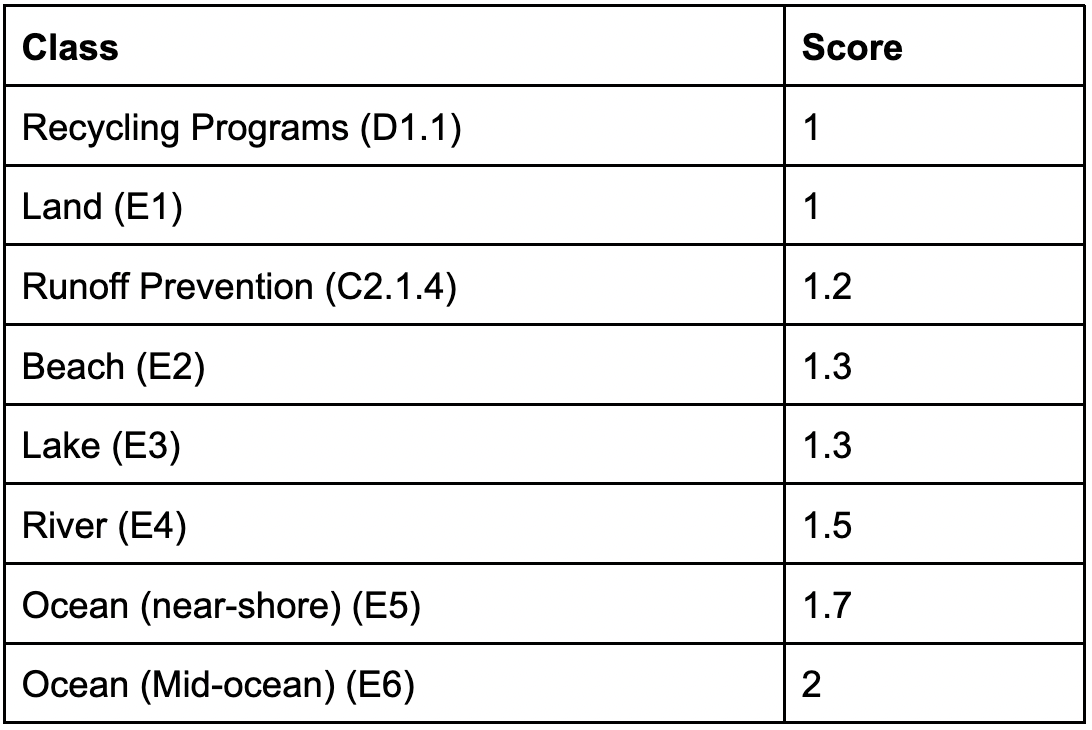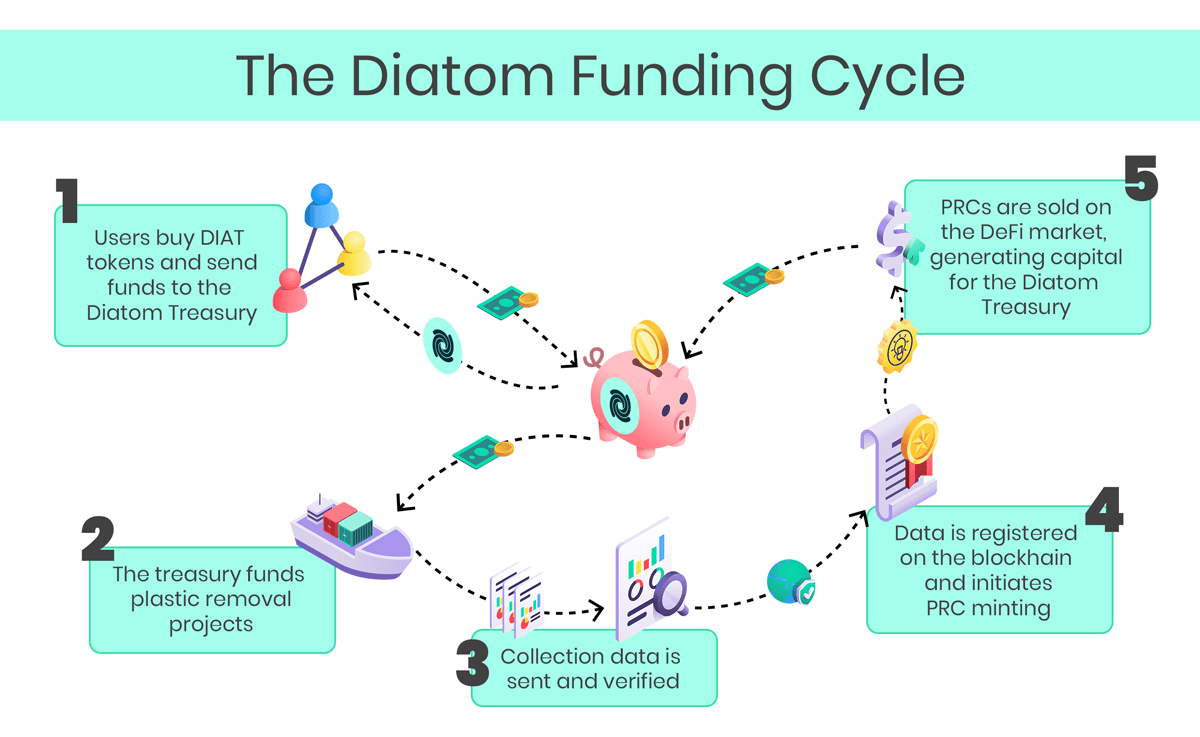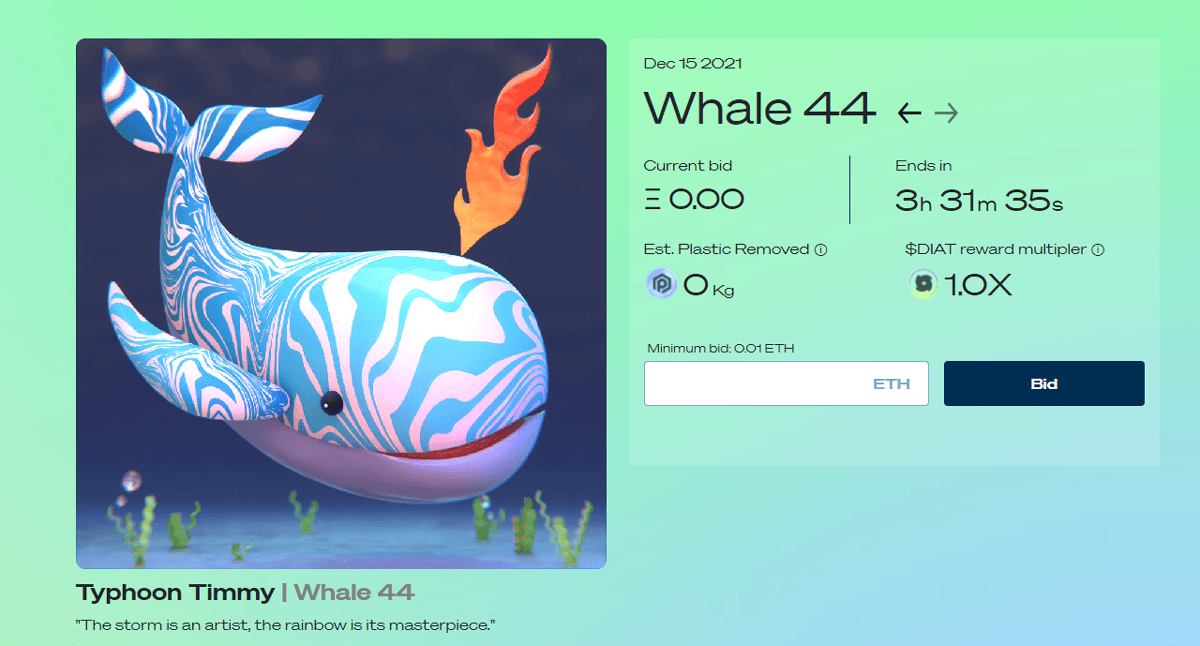In this Diatom DAO review, we take a closer look at a blockchain project that aims to incentivize the removal of plastic from the ocean. With 14 million tons of plastic ending up in our oceans every year, it’s one of the most glaring issues humanity is facing nowadays. This junk disrupts ecosystems, kills entire species, and destroys biodiversity. Moreover, it is directly responsible for climate change as it removes the oceans’ ability to sequestrate greenhouse gasses from the atmosphere.
Although humans are working towards reducing our plastic output, getting rid of altogether is nothing but a pipe dream. We have simply become completely dependant on this material in every facet of our lives. However, focusing on ocean de-pollution is a much more palpable objective. But this is a colossal venture, which requires all the help that it can get. This is why projects like Diatom DAO are so essential.
In this article, we will explain why plastic removal is key to fighting climate change and how Diatom wants to improve this process. To this end, we analyze the methodology behind this eco-conscious DAO and see how it can use blockchain tech to meet its goals. Before we get started, let’s analyze the issue at hand and see why it needs to be thwarted without delay.
Why Depolluting the Oceans Is Essential to Fighting Climate Change
The ocean is one of the most critical resources on Earth. It covers 70% of the planet’s surface, houses 80% of all of its species, and plays a vital role in maintaining temperature balance. More importantly, the ecosphere that lives in the oceans is responsible for producing more than 50% of the oxygen in our atmosphere.
And like most of our natural assets, we have taken oceans for granted. This has led humans to mindlessly pollute oceans and jeopardize the very equilibrium of this intricate ecosystem. And the biggest culprit in this narrative is plastic.

Plastics brought the modern age to life. They revolutionized every industry known to man by providing a lightweight, durable, and cheap material to produce. But all of this has come at a great cost. This man-made polymer brought so much convenience to our everyday lives that it created our current throwaway culture. Most of the plastic containers we produce have a very short usage cycle but remain in our environment for hundreds of years.
What’s more, most of this plastic ends up in our oceans, where it entangles and suffocates marine wildlife. Birds and whales often mistake it for prey, filling their stomachs with plastic and dying of starvation. Microplastics affect marine microorganisms as well, hindering them from producing oxygen and sequestering CO2 from the atmosphere.
Whales and Diatoms To Reduce Greenhouse Gasses
Diatoms are species of phytoplankton, that are the champions of capturing CO2 from the atmosphere. More than 37 billion tons of greenhouse gasses (GHG) are removed by diatoms every year. They also exhale around 50% of all oxygen produced on Earth. What’s even more interesting, is their incredible synergy with another important natural climate change actor – whales.

Whales eat phytoplankton and store carbon dioxide in their bodies over their lifetime. At the same time, their excrements create nutrients that allow phytoplankton to grow and proliferate. And once they die, they take the CO2 with them to the bottom of the oceans, where it’s sequestrated for hundreds of years. A single blue whale can store more than 30 tons of CO2 during its life, compared to the around 15 kg captured by a tree each year.
Reducting the existing plastic in the oceans is vital to increasing the whale population and therefore, phytoplankton. According to the IMF, even a single percent of additional phytoplankton in the oceans would contribute to capturing millions of tonnes of additional GHG. Which brings us to our Diaotom DAO review – what is it exactly?
Diatom DAO Review – What Is It?
Diatom DAO has a deep understanding of the issues of ocean pollution. For this reason, this blockchain project has created a way to incentivize individuals and organizations to participate in a global ocean cleaning. To this end, it uses the OlympusDAO technology and provides a means to fund projects that aim to remove plastic from the oceans. The main goal is to use the capabilities of DeFi to build a reliable supply chain for plastic removal.
To achieve this, the DAO created a tokenized Plastic Removal Credit (PRC) framework. The DAO issues these credits based on verified proof of plastic removal. These credits can then be bought on the voluntary market by various institutions and governments to offset their carbon footprint.
In a previous article about Toucan Protocol, we discussed the voluntary carbon credits market in length. While there’s some room for debate on the benefits and drawbacks of the concept, we concluded that voluntary carbon markets provide non-negligible benefits. Moreover, in this case, measuring PRCs is a much more manageable endeavor, as they translate to physically removed plastics from the oceans.
With this small digression out of the way, let’s carry on with our Diatom DAO review and see how it works from the inside.
What Are Plastic Removal Credits?
You must have guessed by now that the most essential elements in this DAO are the PRC assets. But how are these created exactly? Diatom DAO follows a strict methodology that relies on transparent and verified plastic removal from vetted organizations. To this end, Diatom has partnered with Cleanhub. This third-party solution offers a well-oiled mechanism for verifying and tracking waste removal data.
Diatom, on the other hand, provides a direct bridge to the blockchain for this data. The project takes advantage of the technology to record the Cleanhub data in an immutable and transparent way. This allows for an equitable and impartial minting of the PRCs, where every participant can consult this vital information.
In the carbon market, credits providers usually issue credits to the amount of 1 ton of carbon removed = 1 credit. But with plastic, this doesn’t quite work that way. You see, all plastic trash doesn’t have the same negative impact on the environment. This impact depends on where it was found, how it was collected, and the nature of the plastic itself.
To more accurately represent the impact of plastic removal, Diatom rewards PRCs following a strict classification. This reflects the difficulty of the process as well as the direct threat to the environment. At the same time, it allows for a more realistic representation of the process in PRCs.

Let’s take a look at a quick example. Following Diatom’s scoring table above, 1 ton of plastic removed from mid-ocean will be worth 2 PRC. On the other hand, 1 ton of plastic removed on land equals 1 PRC. You can learn more about this classification and prioritization in their whitepaper.
How Does Diatom Work?
Just like whales’ and phytoplankton’s synergy works in a cycle, so does the Diatom DAO.

First and foremost, this cycle begins by funding the DAO’s treasury. Diatom DAO relies on this treasury to fund PRC-compliant projects and has created the proprietary DIAT token to this end. Users buy DIAT tokens, which increases their capital for financing.
To have better control over its liquidity, Diatom chooses to own the liquidity pools in its treasury. This removes the dependence on rogue liquidity providers that could disrupt the balance of the treasury by withdrawing huge amounts of liquidity at once.
The DAO then finances organizations that actively remove plastic from the environment. After the plastic is removed from the ocean by the participants, it’s weighted and verified transparently. This immediately triggers the creation of PRCs, which are put into the DAO treasury as separate assets.
Finally, corporations and individuals buy PRC’s and “retire” them to provably remove plastic pollution. This has the goal to fill the treasury with even more funds and restart the funding cycle once again. At the same time, organizations can offset their carbon footprint and directly sponsor plastic removal projects.
Diatom DAO Review – Introducing Whalez NFTs
To express the aforementioned critical role of whales in the marine ecosystem, Diatom has created a limited collection of 50 Whalez NFTs. Every token has a neat unique artwork, but also a representation of its worth of kilograms of plastic removed. This way, investors have a clear view of the impact their NFT purchase is making for the greater good.

However, the auction has an added bonus. Not only do buyers receive the NFT, but also an equal amount of DIAT for the price they have paid for the artwork. The first 10 buyers were even able to get a bonus multiplier for their purchase, increasing their DIAT holdings considerably. This allowed buyers to acquire DIAT tokens without the cap imposed by the public sale of the tokens.
Worth mentioning is that DIAT acquired through the NFT auction will be subjected to a vesting period of 24 months. This removes the ability to dump said tokens immediately and crash the price while the first few funding cycles haven’t been completed.
The auction’s goal was to jumpstart Diatom’s treasury, and so far, it has been a stunning success. The most expensive Whale was sold for 283 ETH, over a million dollars at the period of the sale. So far, the auction itself has managed to raise more than 1800 ETH, equating to $7 million at the time of writing.
Our Diatom DAO Review Conclusion
Diatom DAO is a rare sight in the blockchain ecosystem. It has a genuine goal to use the capabilities of the DeFi space for the greater good. Many businesses that are trying to participate in plastic removal programs simply lack the funding for it. This process requires expensive machinery and a lot of manpower to be efficient. And both can be quite hard to come by when starting out.
Diatom DAO tries to alleviate this issue by creating a transparent treasury and providing direct funding for these organizations. Moreover, it creates PRCs using verified methodology that allows institutions and individuals to offset their carbon footprint in a provable manner. The end result should create a robust supply chain for plastic removal from the oceans, and everyone on the planet would benefit from it.
If it wasn’t clear by now I throughout this Diatom DAO review, let’s put it in the open – we are excited to see how this project turns out. The team has made a lot of promises and set some clear goals for the near future. And while it’s still in a nascent state (released November 2021), millions of dollars have already been funneled into the treasury. This gives us high hopes for the upcoming developments of the Diatom DAO.
